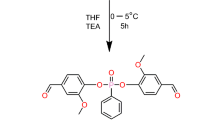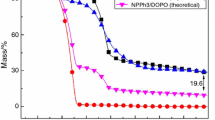Abstract
Phosphate ester compounds display good flame retardancy effect in epoxy resin systems. In this paper, several novel phosphate esters, used as curing agents for epoxy resins, were synthesized based on P2O5, phosphoric acid, and different types of alcohol. The structures of phosphate esters were characterized by 31P nuclear magnetic resonance (31P NMR). Then, a series of flame retardant epoxy composites were prepared by curing the epoxy resins (E-44) with the phosphate esters. The flame retardancy and thermal degradation behaviors of flame retardant epoxy composites were investigated by cone calorimeter test (CCT) and thermogravimetric analysis (TGA), respectively. The results of CCT indicated that phosphate esters can significantly decrease heat release rate, total heat release (THR), and smoke production rate. The sample cured by butyl phosphate ester from phosphorus pentoxide, phosphoric acid and butanol showed the best flame retardant performance among all samples. The TGA results showed that phosphate esters could enhance char residues of flame retardant epoxy composites when compared with those of a composite using T31 as a curing agent at high temperature. It may be concluded that good flame retardant properties of flame retardant epoxy composites are related to the formation of a protective phosphorus-rich char layer. These phosphate esters have a good future on flame retardant epoxy composites.









Similar content being viewed by others
References
Zhu JH, Chen MJ, He QL, Shao L, Wei SY, Guo ZH (2013) An overview of the engineered graphene nanostructures and nanocomposites. RSC Adv 3:22790–22824
Gu HB, Tadakamalla S, Zhang X, Huang YD, Jiang Y, Colorado HA, Luo ZP, Wei SY, Guo ZH (2013) Epoxy resin nanosuspensions and reinforced nanocomposites from polyaniline stabilized multi-walled carbon nanotubes. J Mater Chem 1:729–743
Gu HB, Tadakamalla S, Huang YD, Colorado HA, Luo ZP, Neel H, Young DP, Wei SY, Guo ZH (2012) Polyaniline stabilized magnetite nanoparticles reinforced epoxy nanocomposites. ACS Appl Mater Int 4:5613–5624
Zhang X, Alloul O, Zhu JH, He QL, Luo ZP, Colorado HA, Neel H, Young DP, Shen TD, Wei SY, Guo ZH (2013) Iron core carbon shell nanoparticles reinforced electrically conductive magnetic epoxy resin nanocomposites with reduced flammability. RSC Adv 3:9453–9464
Zhang X, He QL, Gu HB, Wei SY, Guo ZH (2013) Polyaniline stabilized barium titanate nanoparticles reinforced epoxy nanocomposites with high dielectric permittivity and reduced flammability. J Mater Chem 1:2886–2899
Zhu JH, Wei SY, Yadav A, Guo ZH (2010) Rheological behaviors and electrical conductivity of epoxy resin nanocomposites suspended with in situ stabilized carbon nanofibers. Polymer 51:2643–2651
Hayaty M, Honarkar H, Beheshty MH (2013) Curing behavior of dicyandiamide/epoxy resin system using different accelerators. Iran Polym J 22:591–598
Jiao CM, Dong J, Chen XL, Li SX (2013) Influence of T31 content on combustion and thermal degradation behaviors on flame-retardant epoxy composites. J Therm Anal Calorim 114:1201–1206
Lu S, Ban J, Yu C, Deng W (2010) Properties of epoxy resins modified with liquid crystalline polyurethane. Iran Polym J 19:669–678
Seibold S, Schaefer A, Lohstroh W, Walter O, Doering M (2008) Phosphorus-containing terephthaldialdehyde adducts-structure determination and their application as flame retardants in epoxy resins. J Appl Polym Sci 108:264–271
Wu Q, Bao JW, Zhang C, Liang R, Wang B (2011) The effect of thermal stability of carbon nanotubes on the flame retardancy of epoxy and bismaleimide/carbon fiber/buckypaper composites. J Therm Anal Calorim 103:237–242
Everson K, Baljinder KK, Myler P (2013) Evaluating the influence of varied fire-retardant surface coatings on post-heat flexural properties of glass/epoxy composites. Fire Saf J 58:112–120
Gu HB, Guo J, He QL, Tadakamalla S, Zhang X, Yan XR, Huang YD, Colorado HA, Wei SY, Guo ZH (2013) Flame retardant epoxy resin nanocomposites reinforced with polyaniline stabilized silica nanoparticles. Ind Eng Chem Res 52:7718–7728
Zhang X, He QL, Gu HB, Colorado HA, Wei SY, Guo ZH (2013) Flame retardant electrical conductive nano-polymers based on bisphenol F epoxy resin reinforced with nano polyanilines. ACS Appl Mater Inter 5:898–910
Toldy A, Toth N, Anna P, Keglevich Gy, Kiss K, Marosi Gy (2006) Flame retardancy of epoxy resin with phosphorus-containing reactive amine and clay minerals. Polym Adv Technol 17:778–781
Liang B, Cao J, Hong XD, Wang CS (2013) Synthesis and properties of a novel phosphorous-containing flame-retardant hardener for epoxy resin. J Appl Polym Sci 128:2759–2765
Wang CS, Berman JR, Walker LL, Mendoza A (1991) Meta-bromobiphenol epoxy resins: applications in electronic packaging and printed circuit board. J Appl Polym Sci 43:1315–1321
Levchik SV, Well ED (2004) Thermal decomposition, combustion and flame-retardancy of epoxy resins––a review of the recent literature. Polym Int 12:1901–1929
Feng JX, Su SP, Zhua J (2011) An intumescent flame retardant system using β-cyclodextrin as a carbon source in polylactic acid (PLA). Polym Adv Technol 22:1115–1122
Ding JP, Tao ZQ, Zuo XB, Fan L, Yang SY (2009) Preparation and properties of halogen-free flame retardant epoxy resins with phosphorus-containing siloxanes. Polym Bull 62:829–841
Hsiue GH, Wang WJ, Chang FC (1999) Synthesis, characterization, thermal and flame-retardant properties of silicon-based epoxy resins. J Appl Polym Sci 73:1231–1238
Mercado LA, Galià M, Reina JA (2006) Silicon-containing flame retardant epoxy resins: synthesis, characterization and properties. Polym Degrad Stab 91:2588–2594
Zhang XH, Wan HM, Min YQ, Qi GR (2005) Novel nitrogen-containing epoxy resin. I. Synthetic kinetics. J Appl Polym Sci 96:723–731
He QL, Yuan TT, Yan XR, Ding DW, Wang Q, Luo ZP, Shen TD, Wei SY, Cao DP, Guo ZH (2014) Flame-retardant polypropylene/multiwalll carbon nanotube nanocomposites: effects of surface functionalization and surfactant molecular weight. Macromol Chem Phys 215:327–340
He QL, Yuan TT, Wei SY, Guo ZH (2013) Catalytic and synergistic effects on thermal stability and combustion behavior of polypropylene: influence of maleic anhydride grafted polypropylene stabilized cobalt nanoparticles. J Mater Chem 1:13064–13075
Li L, Qian Y, Jiao CM (2012) Influence of red phosphorus on the flame-retardant properties of ethylene vinyl acetate/layered double hydroxides composites. Iran Polym J 21:557–568
Liu Y, Pearce EM, Weil ED (1999) Flame retardancy of dicyandiamide-crosslinked epoxy resins containing phenolphthalein structures and/or a phosphorus-containing additive. J Fire Sci 17:240–258
Liu YL, Hsiue GH, Lee RH, Chiu YS (1997) Phosphorus-containing epoxy for flame retardant. III: using phosphorylated diamines as curing agents. J Appl Polym Sci 63:895–901
Wang CS, Shieh JY (1999) Phosphorus-containing epoxy resin for an electronic application. J Appl Polym Sci 73:353–361
Zhu JH, Wei SY, Ryu J, Sun LY, Luo ZP, Guo ZH (2010) Magnetic epoxy resin nanocomposites reinforced with core-shell structured Fe@FeO nanoparticles: fabrication and property analysis. ACS Appl Mater Inter 2:2100–2107
Zhu JH, Wei SY, Ryu J, Budhathoki M, Liang G, Guo ZH (2010) In-situ stabilized carbon nanofibers (CNFs) reinforced epoxy nanocomposites. J Mater Chem 20:4937–4948
Jiao CM, Zhuo JL, Chen XL, Li SX, Wang HJ (2013) Flame retardant epoxy resin based on bisphenol A epoxy resin modified by phosphoric acid. J Therm Anal Calorim 114:253–259
Chen XL, Jiao CM, Li SX, Sun J (2011) Flame retardant epoxy resins from bisphenol-A epoxy cured with hyperbranched polyphosphate ester. J Polym Res 18:2229–2237
Morgan AB, Matthew B (2007) Cone calorimeter analysis of UL-94 V rated plastics. Fire Mater 31:257–283
Grazyna J, Agnieszka KJ, Przemysław R (2011) Thermal stability, flammability and fire hazard of butadiene-acrylonitrile rubber nanocomposites. J Therm Anal Calorim 103:1039–1046
Zhong HF, Wei P, Jiang PK, Wang GL (2007) Thermal degradation behaviors and flame retardancy of PC/ABS with novel silicon-containing flame retardant. Fire Mater 31:411–423
Wang XY, Li Y, Liao WW, Gu J, Li D (2008) A new intumescent flame-retardant: preparation, surface modification, and its application in polypropylene. Polym Adv Technol 19:1055–1061
Filipczak R, Crowley S, Lyon RE (2005) Heat release rate measurements of thin samples in the OSU apparatus and the cone calorimeter. Fire Safety J 40:628–645
Wang X, Hu Y, Song L, Xing WY, Lu HD, Lv P, Jie GX (2010) Flame retardancy and thermal degradation mechanism of epoxy resin composites based on a DOPO substituted organophosphorus oligomer. Polymer 51:2435–2445
Clayton H (1980) Estimation of rate of heat release by means of oxygen consumption measurements. Fire Mater 4:61–65
Wu XF, Wang Y, Xie LY, Yu JH, Liu F, Jiang PK (2013) Thermal and electrical properties of epoxy composites at high alumina loadings and various temperatures. Iran Polym J 22:61–73
Cullis CF, Hirschler MM (1983) The significance of thermo analytical measurements in the assessment of polymer flammability. Polymer 24:834–840
Acknowledgments
The authors gratefully acknowledge the National Natural Science Foundation of China (No. 51206084) and the Outstanding Young Scientist Research Award Fund from Shandong Province (BS2011CL018).
Author information
Authors and Affiliations
Corresponding author
Rights and permissions
About this article
Cite this article
Jiao, C., Dong, J., Zhang, C. et al. Synthesis and properties of a phosphate ester as curing agent in an epoxy resin system. Iran Polym J 23, 591–598 (2014). https://doi.org/10.1007/s13726-014-0253-8
Received:
Accepted:
Published:
Issue Date:
DOI: https://doi.org/10.1007/s13726-014-0253-8




